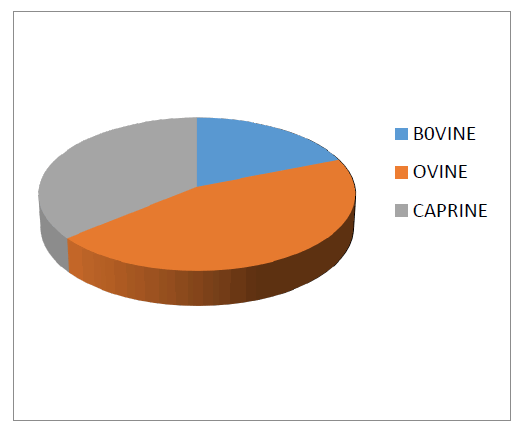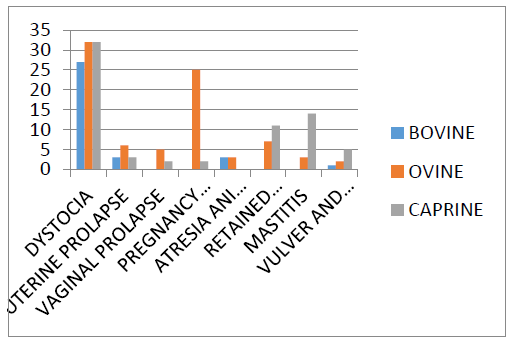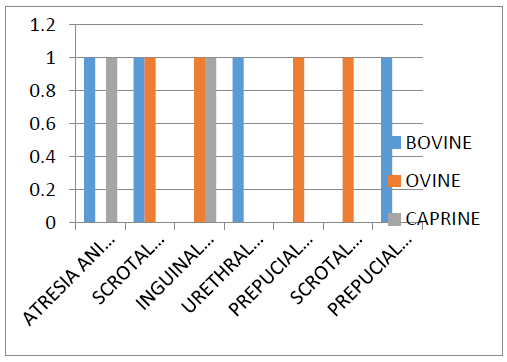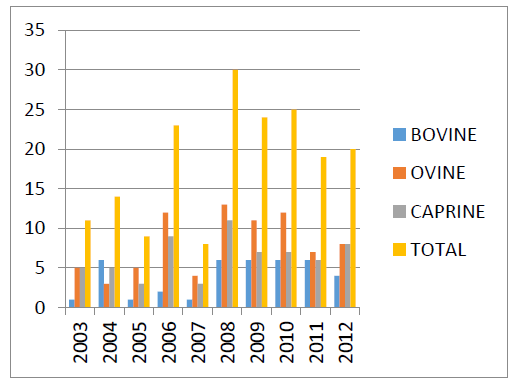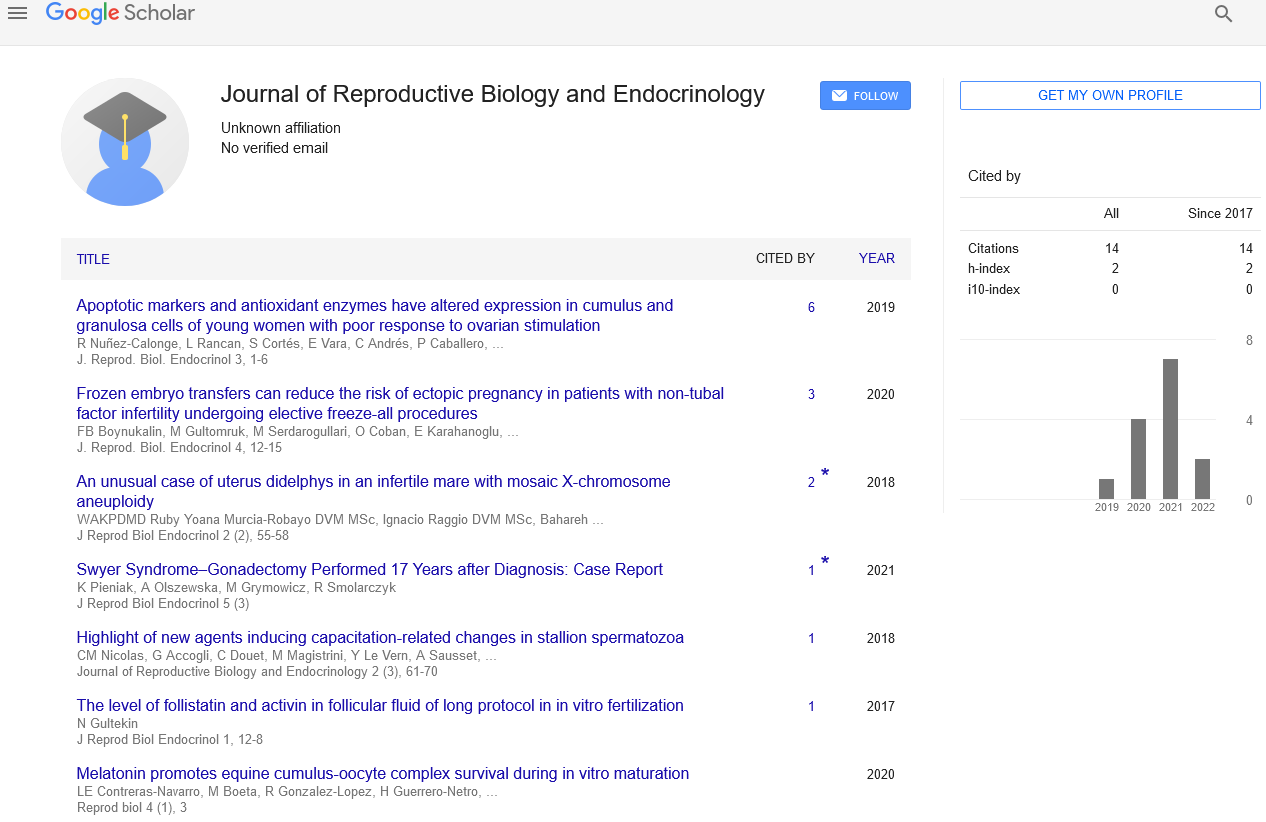Retrospective study on surgical reproductive disease conditions in large animals presented to Ahmadu Bello University Veterinary Teaching Hospital, Zaria
2 National Research Institute for Chemical Technology, Zaria, Nigeria
3 National Agricultural Extension and Research Liaison Service, Ahmadu Bello University, Zaria, Nigeria
Received: 01-Dec-2022, Manuscript No. puljrbe-22-5807; Editor assigned: 03-Dec-2022, Pre QC No. puljrbe-22-5807 (PQ); Accepted Date: Mar 18, 2023; Reviewed: 17-Dec-2022 QC No. puljrbe-22-5807 (Q); Revised: 18-Dec-2022, Manuscript No. puljrbe-22-5807 (R); Published: 20-Mar-2023, DOI: 10.37532/ puljrbe.2023.7(1).1-4
Citation: Lawal A, Tanimu FB, Baidu AL, et al. Retrospective study on surgical reproductive disease conditions in large animals presented to Ahmadu Bello University Veterinary Teaching Hospital, Zaria. J Reprod Biol Endocrinol. 2023;7(1):1-4.
This open-access article is distributed under the terms of the Creative Commons Attribution Non-Commercial License (CC BY-NC) (http://creativecommons.org/licenses/by-nc/4.0/), which permits reuse, distribution and reproduction of the article, provided that the original work is properly cited and the reuse is restricted to noncommercial purposes. For commercial reuse, contact reprints@pulsus.com
Abstract
A 10 year (2003-2014) retrospective study of surgical reproductive conditions in large animals was conducted in Ahmadu Bello University Veterinary Teaching Hospital, Zaria. The rate obtained was analyzed based on species, year of presentation, disease condition and sex using percentage distribution in tabular forms, bar-charts and pie-charts. Ovine had the highest prevalence of 87 (45.10%), Followed by caprine 69 (35.70%) and bovine with the least prevalence rate of 37 (19.20%). Dystocia was the most prevalent reproductive condition with 91 (47.15%) cases, while the surgical reproductive conditions with least prevalence were preputial prolapsed, preputial abscess, ruptured urethra and scrotal hernia each with prevalence of 1 (0.52%). Small ruminants had the highest recorded prevalence of surgical reproductive disease, probably due to the religious and socio-economic importance of these animals especially sheep in northern Nigeria as they are used during festive periods, such as Eid-Elkabir, wedding and naming ceremonies. Bovine had the least prevalence rate owing to the fact that most of the cases in cattle are handled out there as ambulatory cases. Dystocia was the most prevalent surgical reproductive condition during the period of study possibly due to lack of awareness on the side of animal breeders on the possible causes of the condition and crossing of different breeds of variable sizes within the same species thereby causing dystocia due to foetal oversize. Caesarean section was therefore the most commonly used corrective surgical technique. From this study it is therefore recommended that farmers should be educated on the possible causes of such reproductive disease to curtail their occurrence and that more studies should be conducted for longer period to have better understanding of such surgical reproductive diseases.
Key Words
Ovine; Caprine; Bovine; Caesarean; Dystocia; Prevalence
Introduction
Ruminants play an important role in the survival, economic, and social livelihoods of many humans, more significantly in developing countries [1]. Roughly 95.7% of all goats and 63.3% of all ewes are located in developing countries and embody more than 70% of total animal production in the world [2].
High reproductive efficiency of cows is very important for achieving the maximum return from dairy farming. Any abnormality in reproductive system can interrupt animal production performance. Reproductive disorders are the major causes of reducing productivity in cattle that result in failure to produce or delay in producing the annual live calf and reduced lifetime production of cows [3].
This study is therefore aimed at determining the pattern of surgical reproductive diseases encountered at the Ahmadu Bello University Veterinary Teaching Hospital, Zaria, within a Ten-year period
Materials and Methods
Study area
The study was conducted in the veterinary teaching hospital of Ahmadu Bello University Zaria, Kaduna State of Nigeria. Samaru is situated on latitude 1120 120 N and longitude 070 370 E, at an altitude of 550 m-700 m. It is about 13 km from Zaria-city on the Sokoto road, 8 km to Shika and 7 km from Basawa, Zaria itself is a very large, heterogeneous city whose 1.490,000 population comes from different parts of the world.
It is second in size only to the State capital, Kaduna. Zaria is easily accessible from different parts of the country by air via Kaduna, Kano, and Abuja and by rail and road via Kaduna, Jos, Kano and Sokoto. Zaria possesses a tropical continental climate with a pronounced dry season, lasting up to 7 months (October-May). During the dry season, a cool period is usually experienced between November and February. This weather prevails over most parts of the country. The NE winds are characterized by hazy to dusty conditions and low temperatures as low as 42°C at night. In the afternoons up to 42°C is sometimes recorded. The humidity also less than 15% in December/January. Zaria experiences a brief period of hot but dry weather in March and April. The rainy season last from May to September/October with long-term annual rainfall of 1040 mm in about 90 rain days
Sources of data
The data used for the study were obtained from clinical case record files of patients presented with surgical reproductive conditions to the veterinary teaching hospital, Ahmadu Bello University Zaria, Nigeria from January, 2003–December, 2012 (10-year period).
Statistical Analysis
The data were analyzed based on species, year of presentation, disease condition and sex using percentage distribution in a tabular forms, bar-charts and pie-charts.
Results
The analysis of various reproductive disease conditions (surgical) in different sex is presented according to species in (Tables 1-4). A total of 194 reproductive cases were handled in farm animals all of which were ruminants within the period of study. Ovine had the highest prevalence of 87 (45.10%), followed by caprine 69 (35.70%) then bovine 37 (19.20%). Dystocia 91 (47.17%) was most prevalent reproductive condition, this is followed by pregnancy toxemia 27 (13.99%), then retained placenta 18 (19.33%), mastitis 17 (8.81%), uterine prolapse 12 (6.21%), lacerations (mammary gland and scrotum) 9 (4.66%), atresia ani with recto vaginal fistula 6 (3.11%), vaginal prolapsed 5 (2.59%), atresia ani with recto-urethral fistula 2 (1.04%), inguinal hernia 2(1.04%), preputial prolapsed 1 (0.52%), preputial abscess 1 (0.52%), ruptured urethral 1 (0.52%) and scrotal hernia 1 (0.52%).
TABLE 1. Prevalence of female surgical reproductive conditions in different species of large animals presented to ABUVTH, Zaria, from clinical records of 10 years study (2003-2012)
| Conditions | Bovine | Ovine | Caprine | Total |
|---|---|---|---|---|
| Dystocia | 27 | 32 | 32 | 91 |
| Uterine prolapse | 3 | 6 | 3 | 12 |
| Vaginal prolapse | -- | 5 | -- | 5 |
| Pregnancy toxaemia | -- | 25 | 2 | 27 |
| Atresia ani with recto-vaginal fistula | 3 | 3 | -- | 6 |
| Retained placenta | -- | 7 | 11 | 18 |
| Mastitis | -- | 3 | 14 | 17 |
| Vulver and udder laceration | -- | 2 | 5 | 7 |
| Total | 33(18.0%) | 83(45.4%) | 67(36.6%) | 183(100%) |
TABLE 2. Prevalence of male surgical reproductive conditions in different species of large animals presented to ABUVTH, Zaria, from clinical records of 10 years study (2003-2012).
| Conditions | Bovine | Ovine | Caprine | Total |
|---|---|---|---|---|
| Atresia ani with recto-urethral fistula | 1 | -- | 1 | 2 |
| Scrotal hernia | 1 | 1 | -- | 2 |
| Inguinal hernia | -- | 1 | 1 | 2 |
| Urethral rupture | 1 | -- | -- | 1 |
| Prepucial hernia | -- | 1 | -- | 1 |
| Scrotal laceration | -- | 1 | -- | 1 |
| Prepucial abscess | 1 | -- | -- | 1 |
| Total | 4(40%) | 4(40%) | 2(20%) | 10(100%) |
TABLE 3. Prevalence of surgical reproductive conditions in different sex groups of large animals presented to ABUVTH, Zaria, from clinical records of 10 years study (2003-2012).
| Sex | Bovine | Ovine | Caprine | Total |
|---|---|---|---|---|
| Female | 33(18.0%) | 83(45.4%) | 67(36.6%) | 183(100%) |
| Male | 4(40%) | 4(40%) | 2(20%) | 10(100%) |
| Total | 37(19.2%) | 87(45.1%) | 69(35.7%) | 193(100%) |
TABLE 4. Yearly prevalence of female surgical reproductive conditions in different large animal species presented to ABUVTH, Zaria, from clinical records of 10 years study (2003-2012)
| Year | Bovine | Ovine | Caprine | Total |
|---|---|---|---|---|
| 2003 | 1 | 5 | 5 | 11(6.0%) |
| 2004 | 6 | 3 | 5 | 14(7.7%) |
| 2005 | 1 | 5 | 3 | 9(5.0%) |
| 2006 | 2 | 12 | 9 | 23(12.6%) |
| 2007 | 1 | 4 | 3 | 8(4.4%) |
| 2008 | 6 | 13 | 11 | 30(16.4%) |
| 2009 | 6 | 11 | 7 | 24(13.1%) |
| 2010 | 6 | 12 | 7 | 25(13.7%) |
| 2011 | 6 | 7 | 6 | 19(10.4%) |
| 2012 | 4 | 8 | 8 | 20(10.9%) |
| TOTAL | 39(21.3%) | 80(43.7%) | 64(35.0%) | 183(100%) |
A total of 91 dystocia cases where handled, out of which 56 (61.54%) were managed by caesarian session, 27 (29.67%) by manual traction and 7 (7.69%) were treated medically and 1 (1.10%) died before intervention. Moreover, 27 pregnancy toxemias where handled, 5 were treated using caesarian section and the rest were treated medically. Therefore 61 cases were treated using caesarian section. However, there is no record of porcine and equine species with surgical reproductive disease conditions handled throughout the period of study (Figures 1-4).
Figure 1: Pie chart showing the prevalence of surgical reproductive conditions in different species of large animals presented to ABUVTH, Zaria, from clinical records of 10 years study (2003-2012)
Figure 2: Bar chart showing prevalence of female surgical reproductive conditions in different species of large animals presented to ABUVTH, Zaria, from clinical records of 10 years study (2003-2012)
Figure 3: Bar chart showing prevalence of male surgical reproductive conditions in different species of large animals presented to ABUVTH, Zaria, from clinical records of 10 years study (2003-2012)
Discussion
Higher prevalence of surgical reproductive disease conditions in small ruminants (sheep and goat) over cattle (large ruminant) has been recorded. This may be attributed to the fact that species mostly domesticated are small ruminants, probably due to low cost involved in purchasing and rearing them. On the other hand, bovine species are mostly handled outside the clinic as ambulatory case. Hence, there is little or no documentation of ambulatory cases. This is consistent with the report of Mohammede and Waziri but contradicts that of Wosu and Anene [4-6]. The religious and socioeconomic importance of sheep in Northern Nigeria may explain why most inhabitants of Zaria rear them, as it is used during festive periods such as Eid-el-kabir, wedding and naming ceremonies. The number of cattle cases handled within the study period was low despite the report of Williams that Sokoto state is the second largest cattle producing state in Nigeria [7].
Dystocia was the most prevalent reproductive disease. This probably is due to lack of public awareness of animal breeders on the possible causes of dystocia. There is a lot of cross breeding or indiscriminate mating of various breeds of animals of different sizes resulting in dystocia due to fetal oversize. This is consistent with the reports of Wosu and Anene in Nsukka and Waziri et al., in Maiduguri. Dystocia is caused by twinning, poor feeding and management [8]. Free roaming of animals is common scenario in Zaria metropolis. Na Allah reported that most ruminants livestock kept by inhabitants of Sokoto are reared under semi extensive system of production in which they are allowed to roam freely, this is also the same in Zaria; this probably explains the high occurrence of dystocia and pregnancy toxemia [9].
Reproductive diseases conditions were more in females probably due to their unique position as essential reproductive vessels and the facts that females are reared for longer period than males. This is consistent with the reports of Waziri in Maiduguri.
Caesarean section was the most commonly used surgical procedure from this research probably because it is the most suitable surgical procedure for dystocia due to foetal oversize. The disadvantage of fetotomy being that in small ruminants, the clinician is limited by the size of the female pelvis and reproductive tract, making treatment of complicated dystocia difficult [10]. Fortunately, caesarian section in these species is a straight forward procedure with good survival rate for both dam and offspring. An additional advantage is that the procedure can also be done using local anesthesia with or without sedation [11].
Conclusion
The study showed that reproductive disease conditions where more frequent in sheep and female sexes were more vulnerable, with dystocia being the most prevalent reproductive condition encountered within the period of study. Hence caesarean section was the most commonly used surgical technique.
References
- Kosgey IS, Okeyo AM. Genetic improvement of small ruminants in low-input, small holder production systems: Technical and infrastructural issues. Small Rumin Res. 20
- Martins G, Penna B, Hamond C, et al. Leptospirosis as the most frequent infectious disease impairing productivity in small ruminants in Rio de Janeiro, Brazil. Trop Anim Health Prod. 2012; 44:773-7.
[Google Scholar] [Crossref]]
- Shamsuddin M, Bhattacharjee J, Goodger WJ, et al. Community-based productivity veterinary service for smallholder dairy farmers in Bangladesh. Food Agric Organ U N. 2010; 247-53. .
- Mohammed A, Ahmed BC. An analysis of surgical cases at the university of Maiduguri veterinary teaching hospital. Annal of Borno. 1995;11/12:303-08.
[Google Scholar] [Crossref]
- Waziri MA, Adamu A, Bukar MM. Analysis of reproductive cases handled at the state veterinary clinic, Maiduguri, Nigeria. Niger vet j. 2006;27(2):54-9.
- Wosu LO, Anene BM. Incidence and seasonality of reproductive disease conditions in small ruminants in Nsukka area Nigeria. Beir Tropical Landwirtsch Veterinarmed. 1990;28(5):185-89.
- Williams A, Bzugu PM, Atsanda NN. A retrospective study of diseases of ruminants at Maiduguri. Nigeria tropical veterinarian. 2000;18:23-8.
[Google Scholar] [Crossref]
- Arthur GH, Noakes DE, Persea H, et al. Veterinary reproduction and obstetrics. sounder company. 1998.
[Google Scholar] [Crossref]
- Na AY, Tukur HM, Maigandi SA. Et al. Reproductive performance of sheep and goat under traditional management system in Zamfara reserve North-Western Nigeria. Sokoto j vet sci. 2003;5(1):18-20.
- Vermunt JJ. The caesarian operation in cattle: a review. Iran j Vet surg. 2008.
- Kinsani AI, Wachida N. Dystocia Due to Mummified Foetal Moster in a Yankasa Ewe: A Case Report. Int J Anim Vet Adv. 2011;(3):167-69.




